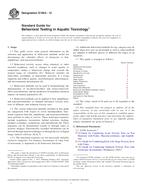Potřebujeme váš souhlas k využití jednotlivých dat, aby se vám mimo jiné mohly ukazovat informace týkající se vašich zájmů. Souhlas udělíte kliknutím na tlačítko „OK“.
ASTM E1604-12
Standard Guide for Behavioral Testing in Aquatic Toxicology
Automaticky přeložený název:
Standardní příručka pro behaviorální testování ve vodní toxikologie
NORMA vydána dne 1.12.2012
Informace o normě:
Označení normy: ASTM E1604-12
Poznámka: NEPLATNÁ
Datum vydání normy: 1.12.2012
Kód zboží: NS-42325
Počet stran: 9
Přibližná hmotnost: 27 g (0.06 liber)
Země: Americká technická norma
Kategorie: Technické normy ASTM
Kategorie - podobné normy:
Anotace textu normy ASTM E1604-12 :
Keywords:
aquatic toxicity, behavior, locomotory activities, respiration, ICS Number Code 07.060 (Geology. Meteorology. Hydrology)
Doplňující informace
| Significance and Use | ||||||||||||||||||||||||||||||||||||||||||
|
5.1 Protection of a species requires the prevention of detrimental effects of chemicals on the survival, growth, reproduction, health, and uses of individuals of that species. Behavioral toxicity provides information concerning sublethal effects of chemicals and signals the presence of toxic test substances. 5.1.1 The behavioral responses of all organisms are adaptive and essential to survival. Major changes in the behavioral responses of fish, amphibians, and macroinvertebrates may result in a diminished ability to survive, grow, or reproduce and cause significant changes in the natural population 5.2 The results from behavioral toxicity tests may be useful for measuring injury in the assessment of damages resulting from the release of hazardous materials 5.3 Behavioral toxicity test methods may be useful for long-term monitoring of effluents (10) . 5.4 The results from behavioral toxicity data can be used to predict the effects of exposure on fish, amphibians, and aquatic invertebrates likely to occur in field situations as a result of exposure under similar conditions, including the avoidance of exposure by motile organisms 5.5 The results from behavioral toxicity tests might be an important consideration for assessing the hazard of materials to aquatic organisms. Such results might also be used when deriving water quality criteria for fish and aquatic invertebrates organisms. 5.6 The results from behavioral toxicity tests can be used to compare the sensitivities of different species, relative toxicity of different chemical substances on the same organism, or effect of various environmental variables on the toxicity of a chemical substance. 5.7 The results from behavioral toxicity tests can be used to predict the effects of long-term exposure. 5.8 The results of behavioral toxicity tests can be useful for guiding decisions regarding the extent of remedial action needed for contaminated aquatic and terrestrial sites. 5.9 The behavioral characteristics of a particular organism must be understood and defined before a response can be used as a measure of toxicity. The range of variability of any behavioral response of unexposed organisms is influenced by genetic, experiential, physiological, and environmental factors. Thus it is important to avoid selecting test organisms from populations that may vary significantly in these factors. 5.10 The results of behavioral toxicity tests will depend on the behavioral response measured, testing conditions, water quality, species, genetic strain, life stage, health, and general condition of test organisms. Therefore, the behavioral response may be affected by the test environment. |
||||||||||||||||||||||||||||||||||||||||||
| 1. Scope | ||||||||||||||||||||||||||||||||||||||||||
|
1.1 This guide covers some general information on the selection and application of behavioral methods useful for determining the sublethal effects of chemicals to fish, amphibians, and macroinvertebrates. 1.2 Behavioral toxicity occurs when chemical or other stressful conditions, such as changes in water quality or temperature, induce a behavioral change that exceeds the normal range of variability (1).2 Behavior includes all observable, recordable, or measurable activities of a living organism and reflects genetic, neurobiological, physiological, and environmental determinants (2). 1.3 Behavioral methods can be used in biomonitoring, the determination of no-observed-effect and lowest-observed-effect concentrations, and the prediction of hazardous chemical impacts on natural populations (3). 1.4 Behavioral methods can be applied to fish, amphibians, and macroinvertebrates in standard laboratory toxicity tests, tests of effluents, and sediment toxicity tests. 1.5 The various behavioral methods included in this guide are categorized with respect to seven interdependent, functional responses that fish, amphibians, and macroinvertebrates must perform in order to survive. These functional responses include respiration, locomotion, habitat selection, feeding, predator avoidance, competition, and reproduction 1.5.1 The functional responses are not necessarily mutually exclusive categories. For instance, locomotion, of some form of movement, is important to all behavioral functions. 1.6 Additional behavioral methods for any category may be added when new tests are developed as well as when methods are adapted to different species or different life stages of an organism. 1.7 This guide is arranged as follows:
1.8 The values stated in SI units are to be regarded as the standard. 1.9 This standard does not
purport to address all of the safety concerns, if any, associated
with its use. It is the responsibility of the user of this standard
to establish appropriate safety and health practices and determine
the applicability of regulatory limitations prior to use.
Guide for Conducting Sediment Toxicity
Tests with Freshwater Invertebrates (Withdrawn 1995) Standard Guide for Conducting Early
Life-Stage Toxicity Tests with Fishes Standard Guide for Conducting Acute
Toxicity Tests on Test Materials with Fishes, Macroinvertebrates,
and Amphibians (Includes all amendments and changes 2/22/2023). |
Doporučujeme:
EviZak - všechny zákony včetně jejich evidence na jednom místě
Poskytování aktuálních informací o legislativních předpisech vyhlášených ve Sbírce zákonů od roku 1945.
Aktualizace 2x v měsíci !
Chcete vědět více informací? Podívejte se na tuto stránku.




 Cookies
Cookies
